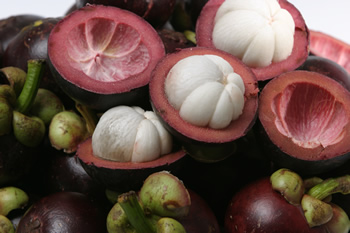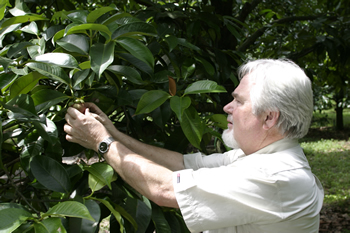Positive Health Online
Your Country

The Mangosteen Fruit - Garcinia mangostana - Science and Ongoing Research
by Dr Frederic Templeman(more info)
listed in nutraceuticals, originally published in issue 152 - November 2008
Commonly called 'mangostan', 'mangostana', 'mangosteen,' or 'mankut', depending on where you may be, Garcinia Mangostana has moved far beyond its humble origins in Indonesia. Even the fact that the Indonesians claim it as a native fruit is strongly disputed by the Thai, who have anointed it their 'national fruit'. Since the 17th century French physician explorer Laurentius Garcin lent his name to the genus "Garcinia", this succulent tropical fruit, which is harvested twice yearly, has spread to about seventeen countries in the tropical belt encircling the earth.

The size of a tangerine with a thick purple rind the texture of pomegranate skin, the mangosteen is sought both for its exotic-tasting segmented white center and for the medicinal compounds which abound in its rind. In the late 19th century, David Fairchild, an English botanist commented on the gastronomical value of the fruit: "It outranks in delicacy, if not all other fruits in the world, certainly all others of the tropical zone, and it is a joy to the eye as well as to the palate to feast on mangosteens."[1] However, before Fairchild, the traditional healers of the Ming Dynasty,[2] as well as the Aryuvedic sages of India,[3] were extolling the mangosteen's medicinal properties. And in the temple of the Golden Buddha in Bangkok, a Sanskrit manuscript 600 years old records the multiple uses that Thai traditional healers have elaborated for the fruit's rind.
Employed for a multiplicity of applications ranging from dermatological conditions to dysentery and infections, the wide range of traditional uses of the mangosteen set it apart from most other medicinal plants which, habitually have but a few documented properties. Both internal (steeped teas) and topical preparations have been used traditionally and now, the mangosteen rind is found in modern creams, ointments, soaps, shampoos, cosmetics and confectionary, as well as in wines and functional health beverages. The market growth for the fruit has been such that, predictions that the mangosteen would eclipse Aloe Vera as the world's most popular natural product, no longer seem exaggerations.
The fruit contains significant quantities of several classes of phytochemicals such as oligomeric proanthocyanidins, catechins and polysaccharides, as well as smaller amounts of plant sterols. Additionally, the mangosteen contains 39 of the polyphenolic xanthones[4] which can be found commercially only in the mangosteen's cousin St John's Wort. This latter class of therapeutic phytochemicals (xanthones) has attracted a great deal of academic interest since its first research article in 1855 when the first xanthone (mangostin) was isolated.[5] From that time to the present, both clinical and laboratory studies have researched the fruit's medicinal qualities.
The xanthone skeleton is a planar phenolic ring molecular structure with alternating double carbon bonds, which impart a robust stability capable of resisting extremes of temperatures while still retaining its integrity. About 250 xanthones have been identified in nature and 39 of them are present in the mangosteen, making it the most prolific source of these phytochemicals which have numerous academic papers on xanthones alone and which continue to hold strong interest for investigators attempting to elucidate the traditional medical secrets of plants.

The anti-inflammatory properties of the xanthones have received significant attention, as they attempt to explain many of the traditional medicinal applications of the fruit. However, other scientists have investigated xanthones, values as antioxidants and, recently, the superoxide scavenging capacity of some fermented preparations of the fruit rind, demonstrating that the potency of superoxide dismutase (the antioxidant enzyme, SOD) activity is unsurpassed by any other natural product preparation.
Additionally, in vitro evidence of significant anti-histamine,[6] antitumour[7] and antibacterial[8] activity of rind components is impressive, particularly as they reference a wide variety of neoplasms and several antibiotic-resistant strains of Staphylococcus[9] and Enterococcus.[10] Such findings help explain the interest that mangosteen has generated. In fact, several researchers have noted in the conclusions of their investigations that they found it unusual that the phytochemicals they had investigated had not yet found an application in formal medical therapeutics.
The research into the value of the fruit's medical potential has not been simply the investigation of theoretical applications. Evaluation of the anti-tumour potential of several xanthones compared the apoptotic activity of a mangosteen xanthone (Garcinone E) to six commonly used chemotherapeutic compounds with surprising results.[11] Investigators examining the antibiotic value of alpha mangostin noted that the xanthone not only demonstrated direct antibacterial activity against methicillin resistant Staphylococcus aureus but, when present in even smaller quantities, the xanthone appeared to counteract the resistance of the bacteria to the extent that methicillin became, once again, active against the superbug (MRSA).
The mangosteen fruit rind, according to Dr Julia Morton, a botanist with specific expertise in the fruit, is 25% catechin by weight.[12] This makes it reasonable to conclude that the well-documented effects of green tea, principally attributed to Epigallocatechingallate, could also be attributed to mangosteen preparations possessing a catechin content quantitatively and qualitatively similar to that of green tea.
A fact of great significance which is often ignored when discussing the medicinal effects of botanicals is the fact that it is the network of nutrients and phytochemicals in plants, and not individual compounds, which are responsible for their observed effects. In a scientific environment that emphasizes the reductionist tendency to seek out and identify the 'lead molecule' in a botanical responsible for an identified effect in the hope that such a molecule can be developed into a drug, the baby is quite often literally thrown out with the bath water. Dr Colin Campbell in his book "the China Study" perhaps said what I am attempting to explain more effectively. He writes: "The more we think that a single chemical characterizes a whole food, the more we stray into idiocy.... This way of thinking has generated a lot of poor science."[13]
I would therefore suggest that those who chose to investigate the mangosteen's medicinal properties would be well advised to keep Dr Campbell's warning in mind as they plan their research. The mangosteen's greatest value, in my opinion, lies in the fact that many, not simply a few, classes of phytochemicals are present and active in the fruit. And they are not acting synergistically and additively by accident; rather, Mother Nature has designed, with infinite wisdom, a network of phytonutrients and phytochemicals in perfect proportions that may well defy man's attempts to decipher them. The mangosteen is obviously a medicinal fruit where the whole truly is greater than the sum of its parts.
References
1. Fairchild D. The Mangosteen. J Genetics 6:339-347. 1915.2. Benemerito AN. The Garcinia of South China (Guttiferae). Lingnan Sci. Journ. 15:57-66. 1936.
3. Kirtikar K, Basu B. Indian Medicinal Plants. Vol 1. Dehra Dun, India: International Book Distributors. 1999.
4. Bennett G, Lee H. Xanthones from Guttiferae. Phytochemistry. 28:967-998. 1989.
5. Schmid W. Isolation of mangostin from Garcinia Mangostana Linn. Liebigs Ann. 93(83):83-88. 1855.
6. Nakatani K, Atsumi M, Arakawa T, et al. Inhibitions of histamine release and prostaglandin E2 synthesis by mangosteen, a Thai medicinal plant. Biol Pharm Bull.25(9):1137-1141. 2002.
7. Moongkarndi P, Kosem N, Kaslungka S, Luanratana O, Pongpan N, Neungton N. Antiproliferation, antioxidation and induction of apoptosis by Garcinia mangostana (mangosteen) on SKBR3 human breast cancer cell line. J Ethnopharmacol.90(1):161-166. 2004.
8. Sundaram BM, Gopalakrishnan C, Subramanian S, Shankaranarayanan D, Kameswaran L. Antimicrobial activities of Garcinia mangostana. Planta Med. 48(1):59-60. 1983/05// 1983,
9. Voravuthikunchai SP, Kitpipit L. Activity of medicinal plant extracts against hospital isolates of methicillin-resistant Staphylococcus aureus. Clin Microbiol Infect.11(6):510-512. 2005.
10. Sakagami Y, Iinuma M, Piyasena K, Dharmaratne H. Antibacterial activity of alpha-mangostin against vancomycin resistant Enterococci (VRE) and synergism with antibiotics. Phytomedicine.12(3):203-208. 2005.
11. Ho C, Huang Y, Chen C. Garcinone E, a xanthone derivative, has potent cytotoxic effect against hepatocellular carcinoma cell lines. Planta Med. 68(11):975-979. 2002.
12. Morton J. Fruits of warm climates. Miami 1987.
13. Campbell C. The China Study. Dallas: First BenBella Books. 2004.
Comments:
-
Will Herdman said..
With Over 30 years as Dir Med R&D based in Fungel related brain disorders this is good information.